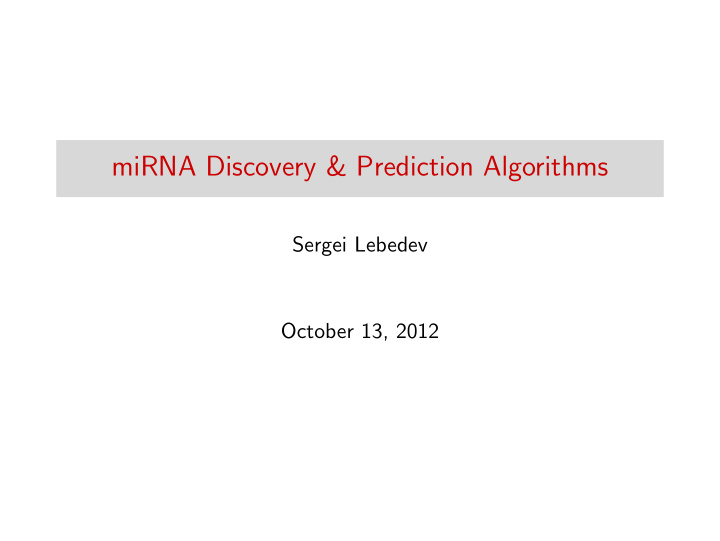



miRNA Discovery & Prediction Algorithms Sergei Lebedev October 13, 2012
What is miRNA? • microRNA or miRNA, ≈ 22 nucleotide-long non-coding RNA; • mostly expressed in a tissue-specific manner and play crucial roles in cell proliferation, apoptosis and differentiation during cell development; • thought to be involved in post-transcriptional control in plants and animals; • linked to disease 1 , for example hsa-miR-126 is associated with retinoblastoma, breast cancer, lung cancer, kidney cancer, asthma etc. 1 See http://www.mir2disease.org for details. 1 / 11
miRNA in action: nucleus [1] • pri-miRNA is transcribed by RNA polymerase II and seem to possess promoter and enchancer regions, similar to protein coding genes; • pri-miRNA is then cleaved into (possibly multiple) pre-miRNA by an enzyme complex Drosha . 2 / 11
miRNA in action: cytoplasm [1] • Dicer removes the stem-loop, leaving two complementary sequences: miRNA and miRNA*, the latter is not known to have any regulatory function. • Mature miRNA base-pairs with 3’ UTR of target mRNAs and blocks protein syntesis or causes mRNA degradation. 3 / 11
miRNA identification • Biological methods: northern blots, qRT-PCR 2 , micro arrays, RNA-seq or miRNA-seq. • Bioinformatics to the rescue! the usual strategy: first sequence everything, RNA-seq in this case, then try to make sense of whatever the result is. • In this talk: miRDeep [2], MiRAlign [3], MiRank [4]. • A lot of existing tools out of scope, most can be described with a one liner: “We’ve developed a novel method for miRNA identification, based on machine learning approach, SVM, HMM!” . 2 RT for reverse transcription, not real-time. 4 / 11
mirDeep 5 / 11
MiRAlign 6 / 11
miRank: overview • Treat miRNA identification problem as a problem of information retrieval, where novel miRNAs are to be retrieved from a set of candidates by the known query samples – “true” miRNAs. • More formally, given a set of known pre-miRNAs X Q as query samples and a set of putative candidates X U as unknown samples , rank X U with respect to X Q . • To do so, compute the relevancy values f i ∈ [0 , 1] for all unknown samples, assuming f i = 1 for query samples. • After that, simply select n ranked samples, which constitute to predicted pre-miRNA. • Makes sense, right? 7 / 11
miRank: how does it work? • miRank models belief propagation process by doing Markov random walks on a graph, where each vertex corresponds to either known pre-miRNA or a putative candidate and two vertices are connected by an edge if the two vertices are “close to each other” . • Each edge on the graph is assigned a weight w ij , proportional to the Euclidean distance between the samples v i and v j (see next slide on how samples are represented). • When a random walker transits from v i to v j it transmits the relevancy information of v i to v j by the following update rule: w ij f ( k +1) p ij f ( k ) � � = α + p ij f j p ij = i j deg ( v ij ) x j ∈ X U x j ∈ X Q 8 / 11
miRank: features Global • normalized minimum free energy of folding (MFE); • normalized no. of paired nucleotides on both arms; • normalized loop length. Local – RNAFold GUAGCACUAAAGUGCUUAUAGUGCAGGUAGUGUUUAGUUAUCUACUGCAUUAUGAGCACUUAAAGUACUGC ((((.(((.(((((((((((((((((.(((((......)).))))))))))))))))))))..))).)))) • Each nucleotide is either paired, denoted by a bracket ( – 5’ arm, ) – 3’ arm, or unpaired – . ; • Each local feature is a “word” of length 3, further distinguished by the nucleotide in the middle position, examples: ((. , .((. 9 / 11
miRank: good parts, bad parts & magic • The method doesn’t require any genomic annotations, except for the set of query samples. • ≈ 75% precision and ≈ 70% recall even with very few query samples (1, 5) – hard to validate, because the source code was never released. • The notion of similarity between query samples, which defines the graph structure is unclear, even though it looks critical for algorithm performance. • Two user-specified parameters, n – number of predicted samples and α – the weight of unknown samples in the relevancy value. How do they affect precision-recall and how to choose them? • Overall, it seems like miRank isn’t used much by biologists 3 . 3 http://www.ncbi.nlm.nih.gov/pubmed?linkname=pubmed_pubmed_ citedin&from_uid=18586744 10 / 11
References K. Chen and N. Rajewsky. The evolution of gene regulation by transcription factors and microRNAs. Nat. Rev. Genet. , 8(2):93–103, Feb 2007. M. R. Friedlander, W. Chen, C. Adamidi, J. Maaskola, R. Einspanier, S. Knespel, and N. Rajewsky. Discovering microRNAs from deep sequencing data using miRDeep. Nat. Biotechnol. , 26(4):407–415, Apr 2008. X. Wang, J. Zhang, F. Li, J. Gu, T. He, X. Zhang, and Y. Li. MicroRNA identification based on sequence and structure alignment. Bioinformatics , 21(18):3610–3614, Sep 2005. Y. Xu, X. Zhou, and W. Zhang. MicroRNA prediction with a novel ranking algorithm based on random walks. Bioinformatics , 24(13):i50–58, Jul 2008. 11 / 11
Recommend
More recommend